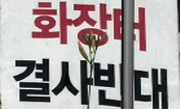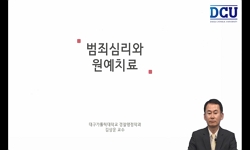In this paper, I wanted to find out the meaning of the criminal pattern in the saga novel through the general features of the crime in the novel and the difference in the form of the man's and woman's crimes. Crimes in the saga reflect the realities o...
http://chineseinput.net/에서 pinyin(병음)방식으로 중국어를 변환할 수 있습니다.
변환된 중국어를 복사하여 사용하시면 됩니다.
- 中文 을 입력하시려면 zhongwen을 입력하시고 space를누르시면됩니다.
- 北京 을 입력하시려면 beijing을 입력하시고 space를 누르시면 됩니다.
https://www.riss.kr/link?id=A106527833
-
저자
한길연 (경북대학교)
- 발행기관
- 학술지명
- 권호사항
-
발행연도
2019
-
작성언어
Korean
-
주제어
sapa novel ; arme ; man's atre women's arme ; metrization of crime ; stigmatizing ; the dramatization of a character contest ; disintegrative shaming ; reintegrative shaming ; disgust ; 대하소설 ; 범죄 ; 남성 범죄 ; 여성 범죄 ; 범죄의 극대화 ; 낙인찍기 ; 악의 극화 ; 인격 투쟁 ; 해체적 수치 ; 재통합적 수치 ; 혐오
-
등재정보
KCI등재
-
자료형태
학술저널
- 발행기관 URL
-
수록면
125-169(45쪽)
-
KCI 피인용횟수
0
- DOI식별코드
- 제공처
- 소장기관
-
0
상세조회 -
0
다운로드
부가정보
다국어 초록 (Multilingual Abstract)
The patter of crime in the saga is problemretic in that it serves as a driving force for readers, but also expresses the male dominated ruling ideology based on the patriarchal systern in the most extreme way. Of course, the pattern of crime in the saga novel can find a positive meaning in that it reveals the deep seated ruture of huten psychology, which was not easily seen in any other genre, as well as the pathological phenomenon in which criminal behavior is maximized amid objections from its own group and society.
In this paper, I wanted to find out the meaning of the criminal pattern in the saga novel through the general features of the crime in the novel and the difference in the form of the man's and woman's crimes. Crimes in the saga reflect the realities of the late Joseon Dynasty, but are extremely shaped in combination with fantastic devices such as monstrous group and evil pill, showing a discricrinatary aspect between male and female criminals. In the case of men, both the wicked and the good are guilty of crime, but most are forgiven rather than punished in spite of strong crites such as murder, and in the older generation, the core figures of the major family except the secondary ones show little criminal behavior. Wanen, on the other hand, frequently appear only to the wicked, and young people, regardless of personal or public crimes, usually end up in the form of death or exit, and only the okler generation has a solid family position and is accepted in consideration of the filial devotion of their ex-wife's children in the saga, the book elaborates the psychological trend of turning into criminals in terms of the stigma of the neighbors and character contest through maximization of crime, while raising interest through destructive criminal acts and deepening the sense of alertness against criminals, providing a mechanism for protection and immunity against men by highlighting the reintegrative sharning of young men, minimizing the age old male crime, and most of the young women were not only conscripted in the form of disintegrative sharing, but they were also clearly showing their abhorrence and rejection of women by deformed and decantarinated to the point of bizarre change in the body of female criminals.
The patter of crime in the saga is problemretic in that it serves as a driving force for readers, but also expresses the male dominated ruling ideology based on the patriarchal systern in the most extreme way. Of course, the pattern of crime in the saga novel can find a positive meaning in that it reveals the deep seated ruture of huten psychology, which was not easily seen in any other genre, as well as the pathological phenomenon in which criminal behavior is maximized amid objections from its own group and society.
국문 초록 (Abstract)
대하소설 속 범죄 양상은 가부장제에 기반한 상층 남성 중심의 이데올로기를 극단적인 방식으로 표출하고 있다는 점에서 문제적이다물론 이러한 이데올로기적 강박 속에서도 범죄에 빠져드는 인간 심리에 대한 깊이 있는 천착과 더불어 소속집단과 사회의 거부 속에서 범죄 행각이 극대화되는 병리 현상까지도 그 이면에서 심도 있게 드러내고 있다는 점에서 대하소설 속 범죄 양상은 긍정적 의미를 찾을 수있다.
본고에서는 대하소설 속 범죄 양상의 전반적 특징과 남녀 범죄인간의 형상화 방식의 차이를 통해 대하소설 속 범죄 양상의 의미를 규명하고자 하였다 대하소설 속 범죄는 조선후기 당대의 ...
본고에서는 대하소설 속 범죄 양상의 전반적 특징과 남녀 범죄인간의 형상화 방식의 차이를 통해 대하소설 속 범죄 양상의 의미를 규명하고자 하였다 대하소설 속 범죄는 조선후기 당대의 현실을 반영하면서도 요도 妖道요약 妖藥등의 환상적 장치와 결합하여 극단적으로 묘사되는 가운데 남녀 범죄인 간에 차별적인 양상을 보이고있었다 남성의 경우 청년층에서는 악인과 선인 모두 범죄 행각을 보이고 있으나 살인 등의 강력한 범죄에도 불구하고 용서받는 경우가대부분이고 장년층에서는 부수적 악인을 제외한 핵심 인물은 범죄행각을 거의 보이지 않는다 반면 여성의 경우에는 악인에 한정하여빈번하게 나타나는데 청년층에서는 사적 공적 범죄를 막론하고 대개죽음이나 출거의 형식으로 징치되며 단지 장년층에서만 가문에서의 입지와 전처소생의 지효를 고려하여 용납되는 방식을 취한다 대하소설에서는 범죄의 극대화를 통해 낙인찍기와 인격투쟁 속에서 범죄인으로 변모해가는 심리적 추이 과정을 섬세하게 보여주는 한편 파괴적 범죄 행각을 선보임으로써 흥미를 고조하고 범죄인들에 대한 경계의식을 심화시키고 있었다 그 가운데 청년층 남성 범죄인의 재통합적 수치를 비중 있게 형상화하고 장년층 남성 범죄를 최소화함으로써 남성에 대한 보호와 면책의 장치를 마련하고 있으며 청년층 여성대개가 해체적 수치를 보이면서 징치될 뿐 아니라 여성 범죄인의 몸을 기괴할 정도로 변형 오염시킴으로써 여성에 대한 혐오와 거부의시선을 극명하게 보여주고 있었다.
대하소설 속 범죄 양상은 가부장제에 기반한 상층 남성 중심의 이데올로기를 극단적인 방식으로 표출하고 있다는 점에서 문제적이다물론 이러한 이데올로기적 강박 속에서도 범죄에 빠져드는 인간 심리에 대한 깊이 있는 천착과 더불어 소속집단과 사회의 거부 속에서 범죄 행각이 극대화되는 병리 현상까지도 그 이면에서 심도 있게 드러내고 있다는 점에서 대하소설 속 범죄 양상은 긍정적 의미를 찾을 수있다.
참고문헌 (Reference)
1 이상택, "「창란호연연작(昌蘭好緣連作)」의 텍스트 교감학(校堪學)" 한국고전문학회 15 : 211-247, 1999
2 마사 너스바움, "혐오와 수치심" 민음사 1-725, 2015
3 "현씨양웅쌍린기"
4 "현몽쌍룡기"
5 채윤미, "한글장편소설의 도교서사 연구 : 『천수석』 및 『임화정연』 연작을 중심으로" 서울대 2018
6 조혜정, "한국의 여성과 남성" 문학과지성사 1-374, 1999
7 "추관지(秋官志)"
8 "증보문헌비고(增補文獻備考)"
9 "조씨삼대록"
10 유승희, "조선후기 형사법상의 젠더gender 인식과 여성 범죄의 실태" 조선시대사학회 (53) : 235-270, 2010
1 이상택, "「창란호연연작(昌蘭好緣連作)」의 텍스트 교감학(校堪學)" 한국고전문학회 15 : 211-247, 1999
2 마사 너스바움, "혐오와 수치심" 민음사 1-725, 2015
3 "현씨양웅쌍린기"
4 "현몽쌍룡기"
5 채윤미, "한글장편소설의 도교서사 연구 : 『천수석』 및 『임화정연』 연작을 중심으로" 서울대 2018
6 조혜정, "한국의 여성과 남성" 문학과지성사 1-374, 1999
7 "추관지(秋官志)"
8 "증보문헌비고(增補文獻備考)"
9 "조씨삼대록"
10 유승희, "조선후기 형사법상의 젠더gender 인식과 여성 범죄의 실태" 조선시대사학회 (53) : 235-270, 2010
11 장병인, "조선전기의 강간범죄-처벌사례에서 나타나는 위정자의 인식을 중심으로-" 역사학회 150 : 83-128, 1996
12 이수옥, "조선 후기 여성과 범죄 : 18세기 『심리록』의 사례 분석을 중심으로" 고려대학교 교육대학원 2003
13 "임화정연" 아세아문화사 1976
14 "임씨삼대록"
15 김준호, "일탈과 범죄의 사회학" 다산출판사 1-379, 2015
16 "유씨삼대록"
17 김진세, "완월회맹연 1-12" 서울대학교 출판부 1987
18 "완월회맹연"
19 "옥란기연"
20 조혜란, "악행(惡行)의 서사화 방식과 진지성의 문제 —<현몽쌍룡기>를 중심으로—" 한국고전연구학회 (23) : 359-398, 2011
21 "쌍성봉효록"
22 "심리록(審理錄)"
23 "소현성록"
24 "성현공숙렬기"
25 윤종현, "성심리학" 성원사 1990
26 마사 C. 누스바움, "분노와 용서" 뿌리와 이파리 1-583, 2018
27 한길연, "몸의 형상화 방식을 통해서 본 고전대하 소설 속 탕녀연구-『쌍성봉효록』의 ‘교씨’와 『임씨삼대록의』의 ‘옥선’을 중심으로" 한국여성문학학회 18 (18): 197-234, 2007
28 "명주옥연기합록"
29 한길연, "대하소설의 요약(妖藥) 모티프 연구 - 미혼단(迷魂丹)과 개용단(改容丹)을 중심으로" 한국고소설학회 (25) : 301-330, 2008
30 장시광, "대하소설의 여성반동인물 연구" 서울대학교 대학원 2004
31 한길연, "대하소설의 남성 악인형 인물 연구 -애욕추구형 악인의 삼각형의 욕망 구도를 중심으로-" 국어국문학회 (164) : 387-418, 2013
32 한길연, "대하소설에 나타나는 ‘남편 폭력담’의 양상과 의미" 한국고전여성문학회 (21) : 69-121, 2010
33 "대명률직해(大明律直解)"
34 "대명률(大明律)"
35 장시광, "고전 대하소설의 강간 모티프 연구" 국어국문학회 (170) : 353-390, 2015
36 서강대학교 인문학연구소, "가와 가문" 서강대학교 출판부 1-158, 1989
37 鄭炳說, "玩月會盟宴 硏究" 서울大學校 大學院 1997
38 김현진, "朝鮮後期의 儒敎論理와 犯罪判決 : 正祖의" 인하대학교 대학원 2012
39 Luckenbill, David F., "Criminal Homicide as a Situated Transaction" 25 (25): 1977
40 Braithwaite, John, "Crime, Shame and Reintergratation" Cambridge University Press 1989
41 Tannenbaum, Frank, "Crime and the Community" Columbia University Press 1938
42 이지하, "<현몽쌍룡기>의 음모구조와 소설적 의미" 한국고전문학회 (47) : 311-342, 2015
43 최수현, "<임씨삼대록>에 나타난 도술의 특징과 그 기능 -애정 욕망 발현 여성을 중심으로" 한국고소설학회 (43) : 127-159, 2017
44 정선희, "<소현성록>에서 드러나는 남편들의 폭력성과 서술 시각" 한국고전여성문학회 0 (0): 452-487, 2007
45 조현우, "<사씨남정기>의 악녀 형상과 그 소설사적 의미" 한국고전여성문학회 (13) : 319-348, 2006
동일학술지(권/호) 다른 논문
-
- 한국고소설학회
- 김동욱
- 2019
- KCI등재
-
종법주의 가부장제 유지를 위한 <창선감의록>의 분노 관리 방식
- 한국고소설학회
- 황혜진
- 2019
- KCI등재
-
- 한국고소설학회
- 김수영
- 2019
- KCI등재
-
- 한국고소설학회
- 윤정안
- 2019
- KCI등재
분석정보
인용정보 인용지수 설명보기
학술지 이력
| 연월일 | 이력구분 | 이력상세 | 등재구분 |
|---|---|---|---|
| 2026 | 평가예정 | 재인증평가 신청대상 (재인증) | |
| 2020-01-01 | 평가 | 등재학술지 유지 (재인증) |  |
| 2017-01-01 | 평가 | 등재학술지 유지 (계속평가) |  |
| 2013-01-01 | 평가 | 등재학술지 유지 (등재유지) |  |
| 2010-01-01 | 평가 | 등재학술지 유지 (등재유지) |  |
| 2008-01-01 | 평가 | 등재학술지 유지 (등재유지) |  |
| 2006-01-01 | 평가 | 등재학술지 유지 (등재유지) |  |
| 2003-01-01 | 평가 | 등재학술지 선정 (등재후보2차) |  |
| 2002-01-01 | 평가 | 등재후보 1차 PASS (등재후보1차) |  |
| 2000-07-01 | 평가 | 등재후보학술지 선정 (신규평가) |  |
학술지 인용정보
| 기준연도 | WOS-KCI 통합IF(2년) | KCIF(2년) | KCIF(3년) |
|---|---|---|---|
| 2016 | 0.93 | 0.93 | 0.97 |
| KCIF(4년) | KCIF(5년) | 중심성지수(3년) | 즉시성지수 |
| 0.87 | 0.91 | 2.301 | 0.09 |




 KISS
KISS







